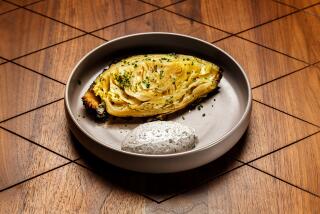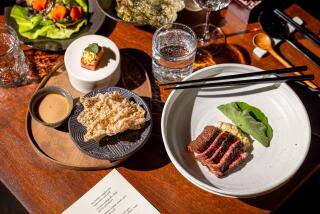Those Pungent Summer Salad Greens Return
- Share via
By now, truck farmers and market gardeners have begun to trickle back to the markets, bringing with them ingredients for, and prospects of, a good green salad. Suddenly the first cuttings of arugula, garden cress and watercress, mizuna, green onions, edible chrysanthemum leaves, pea vine tips, mache and radishes are available again. This fare speaks a pungent language, awakening us from a winter of waterlogged Mexican and California greens.
The sweetness that can be found in fresh-cut local lettuce has begun to assert itself, as has the bitter edge of the various chicories. Now we are in the thick of tender greens that beg for fine, fruity olive oils and careless splashes of fresh-squeezed lemon juice, sprinklings of fresh herbs and coarse grinds of black pepper and sea salt.
Salad, at least the lettuce part of it, was enjoyed by Sumerians and Pharaonic Egyptians, though the lettuce of that age grew in single leaves on tall, thick stalks. Greek philosophers made mention of the leaves as part of their diets.
But it was the gardeners of ancient Rome who developed lettuce into a plant we would probably recognize today, breeding it away from its bitter beginnings. Romaine lettuce does, in fact, have its origins in Rome. It is a cos lettuce, growing in a tall, cylindrical fashion with long, crisp leaves, and it is called cos for a Greek island where the Romans originally found the plant growing wild. Annie Proulx tells us as much in her engaging book on the subject, “The Fine Art of Salad Gardening” (Rodale Press, 1985).
Other members of the lettuce family are referred to as butterhead, like Bibb lettuce and loose-leaf. Among gardeners, black-seeded Simpson is probably the best-known loose-leaf lettuce. True to type, it fails to form a tight rosette of leaves, making itself available instead to the salad fancier who wants to cut a few leaves at a time and leave the plant growing. This would not be possible with a crisp-head such as iceberg.
Iceberg has become something of a joke among lettuces. Grown for its shipping and shelf-life qualities but not flavor, iceberg lettuce is the perfect complement to tasteless, out-of-season tomatoes. Yet it is iceberg lettuce that America eats, about 30 pounds of it for every person in a year, whether picked up with tongs at a salad bar or found hiding between hamburger buns. Mention salad to most people and they don’t think of flavor. They think of the crunch of iceberg, of something like biting into celery, but with an audibly wet undertone. Only iceberg can deliver such a sound. Only iceberg has the right texture.
My sister loved it and, if pressed, would no doubt admit she loves it to this day. How well I remember her slicing a wedge of iceberg lettuce of such perfect dimension she could fit it inside a jar of Marie’s Blue Cheese Dressing. This was her breakfast for a time during her adolescence. No muss, no fuss. No dirty dishes. She would dip and devour, then return the jar of dressing to the refrigerator.
The potential for salad to stand out as a central fixture in a meal first became clear to me at Grandmother Ingle’s home. After the snow had melted and spring had asserted itself, Jessie Ingle would plant a small garden of tomatoes, slicing and pickling cucumbers and lettuce.
It is the red-leaf lettuce, a loose-leaf, that I remember. At some time during our annual summer visit, certainly before the lettuce had bolted with the summer heat, Jessie would pick a bowlful of lettuce and make a wilted lettuce salad for lunch. The smell of bacon cooking in the kitchen was always the giveaway, particularly when the vinegar was added to the pan. There is no smell on earth quite as full of the pleasure to come.
Jessie would cut up eight or 10 pieces of bacon into small pieces, then fry them until crisp. She would remove the bacon from the pan, but save the fat. On low heat, she would add a quarter cup of sugar and a quarter cup of cider vinegar and cook until the sugar had dissolved. Then she would stir in about two tablespoons of water, turn the heat up to medium, and just when the dressing had started to bubble, she would pour it over the lettuce, scatter in the bacon pieces, toss and serve. That and ice tea were often the whole of lunch.
In the past few years, restaurants have demonstrated a penchant for adding nearly anything to greens and calling it salad--flower petals most notably, but a full range of herbs and wild leaves as well, many of which have textures and sharp flavors that override the subtleties inherent in good salads. A busy salad loses its soothing qualities. It becomes a distraction at a meal, rather than a graceful note that either leads into the body of the meal to come or finishes the meal without upstaging what has come before.
A salad my wife and I enjoyed in a small restaurant in Paris last year has become the benchmark against which I measure my own miserable attempts at the art of salad making. Crisp, perfect leaves of blanched, curled endive radiated from the center of the plate. An olive oil of fantastic character had been drizzled over the lot. Then the merest suggestion of vinegar. Finally, an intense grind of sea salt.
There was no place on the plate to hide, no room for confusion or carelessness. It was as simple a salad as can be made. The trick, I think, must be in how to add to this basic formula, to expand on such a theme, without breaking the spell.
Beyond that, when you serve salad--whether at the beginning or the end of the meal--is nobody’s business but your own.






